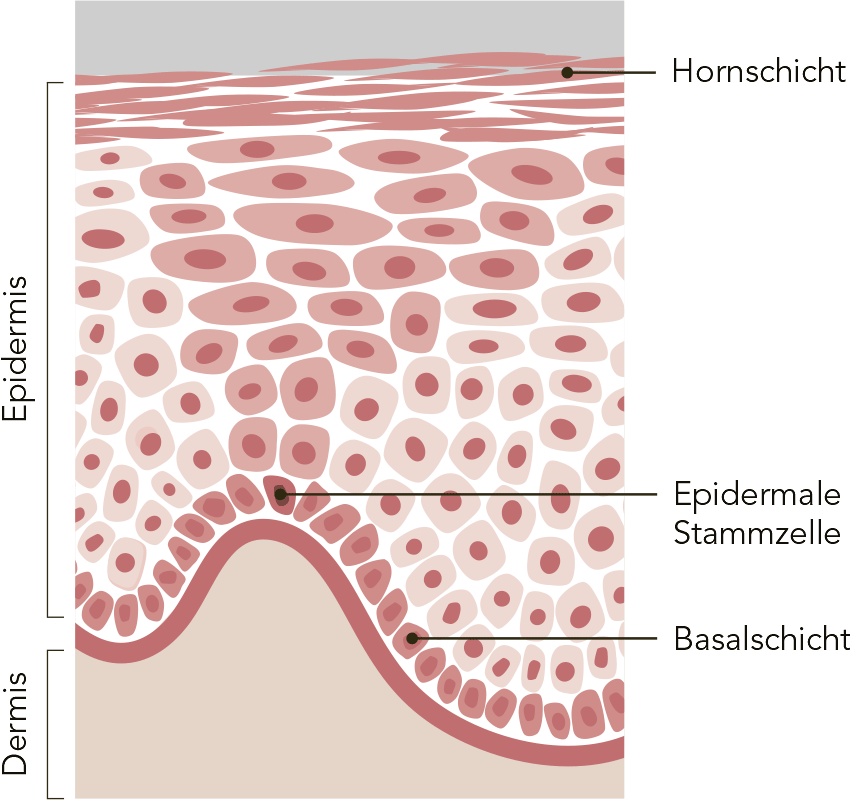Stem cell properties
Stem cells are one of the most fascinating fields in modern biology. They have important properties and serve as our body's repair kits.
Stem cell properties
Stem cells are one of the most fascinating fields in modern biology. They have important properties and serve as our body's repair kits.
What are stem cells?
Renewal and repair are ongoing processes in the human body. Adult stem cells supply the necessary cells for this replacement. They have been identified in over 20 organs or tissues. Two key features set them apart from ordinary cells: They can differentiate into a diverse range of specialized cells of the same tissue and they have the remarkable ability to renew and regenerate themselves through cell division throughout a person's life. This makes stem cells especially valuable and important in regenerative skin care research.
Stem cells in the skin – epidermal stem cells
Adult stem cells are also present in the outer layer of human skin, the epidermis. These cells are called epidermal stem cells and are found in the innermost layer of the epidermis (basal layer). 2-7% of all cells in this layer are stem cells. Although their appearance does not differ from that of the other cells in the basal layer, stem cells have a unique function: They constantly renew and rejuvenate the epidermis by forming new keratinocytes and regenerate damaged tissue as only these cells have the ability to divide indefinitely (see figure).

In young skin, the epidermis fully renews itself approximately every 4 weeks. This process continuously slows as we age. The number of skin stem cells decreases and their vitality diminishes. Excessive UV exposure of the skin and an unhealthy lifestyle (smoking, alcohol) aggravate these effects considerably, resulting in thinner, more deeply wrinkled skin. The hydrolipid film is reduced, which leaves the skin dryer and less well protected. As no new epidermal stem cells can develop during a person's life, it is all the more important to maintain the vitality of these valuable cells and their ability to divide as long as possible.
Plant stem cells protect skin stem cells. How does this work?
Every stem cell contains specific epigenetic factors whose task is to preserve the stem cells' multi-potency and its ability to self-renew. Mibelle Biochemistry researchers have discovered that plant stem cells contain epigenetic factors similar to those of adult human stem cells. Applied in the right way, they have a positive impact on the vitality of skin stem cells and their proper functioning.
How can the vitality of epidermal stem cells be measured?
Is it even possible to improve the vitality of stem cells, keeping the skin youthful longer? Proving this is particularly difficult since epidermal stem cells look exactly the same as the other cells in the basal layer. Only the development of a new test method, the so-called “progenitor cell targeting”, made it possible to isolate stem cells from the human epidermis for test purposes. These epidermal stem cells can be grown in Petri dishes using specific culture media. Using this cell culture test, one of the unique properties of stem cells, the colony-forming efficiency (CFE), can be assessed in the lab. First, very dilute dispersions of epidermal stem cells are plated on Petri dishes. Each vital, healthy stem cell divides , forming a colony of cells, which is visible to the naked eye and can then be counted. Stem cells that have aged and are weakened do not die, but they no longer form such colonies. Researchers were thus able to show that using plant stem cells (all PhytoCellTec™ products) is proven to increase the longevity and colony-forming efficiency – essentially, the vitality – of epidermal stem cells.

